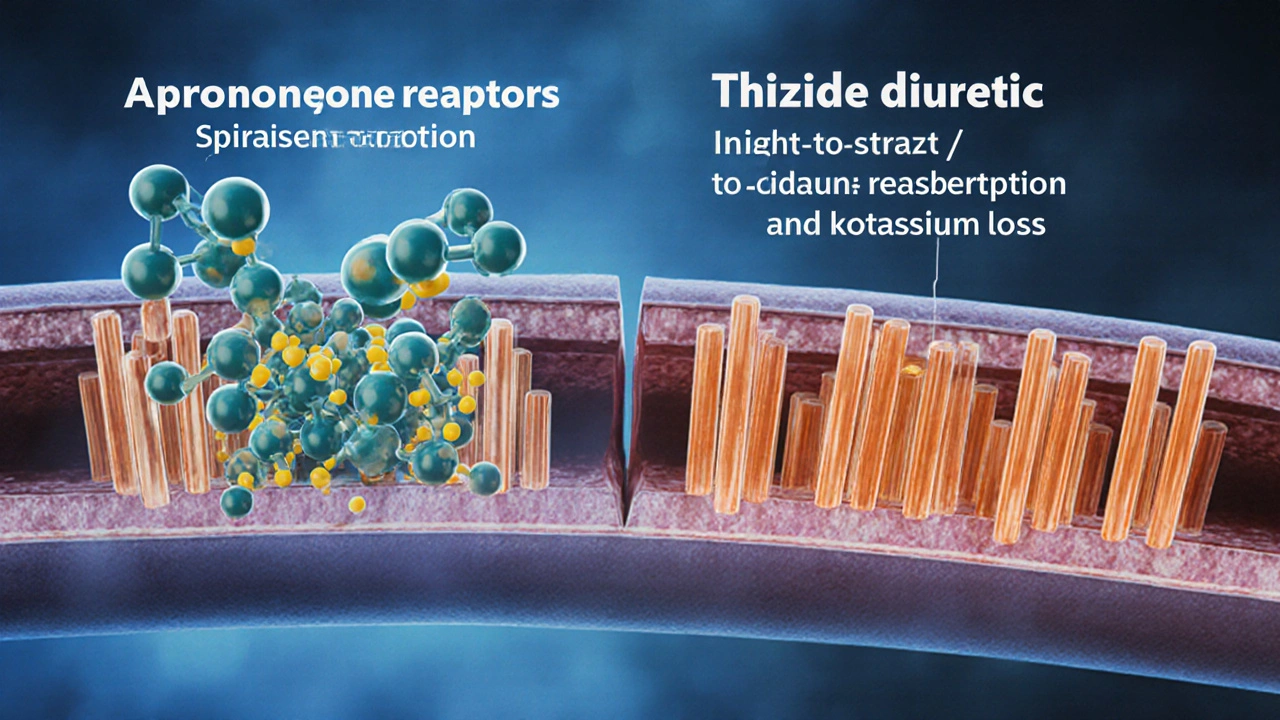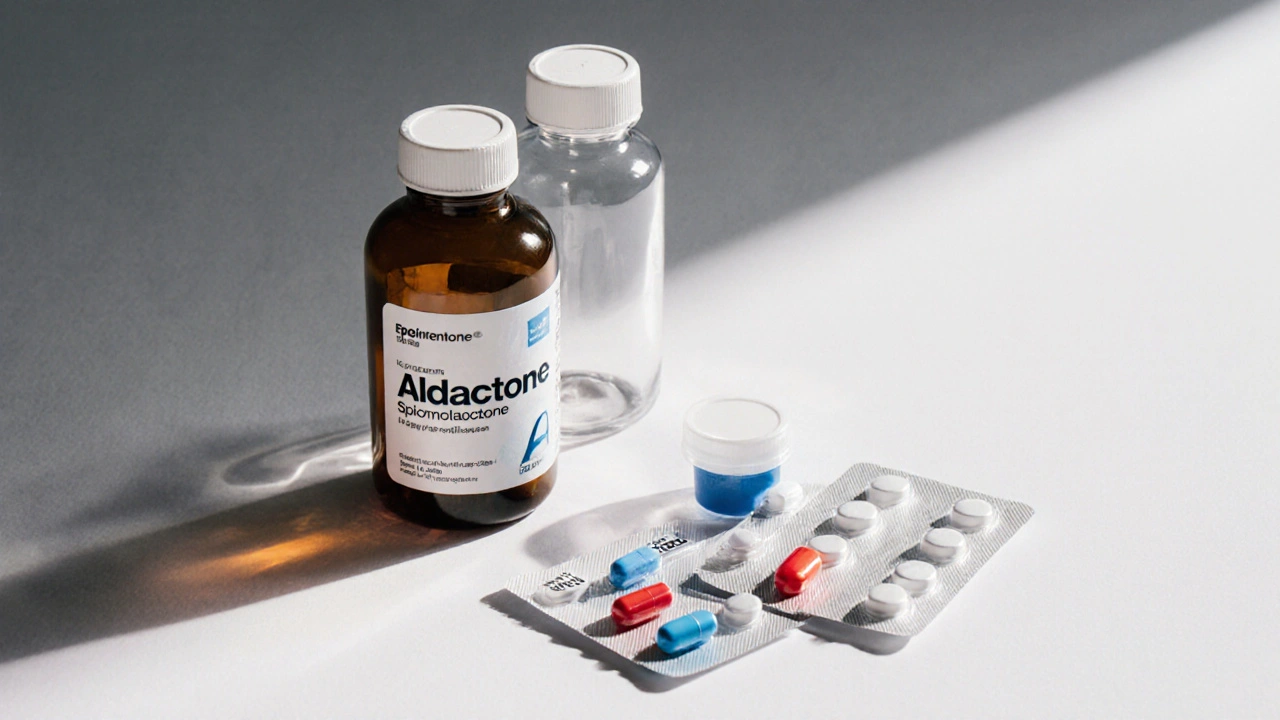Potassium Level Calculator for Spironolactone Alternatives
Calculate Your Potassium Risk
This tool estimates your potassium level based on medications, diet, and kidney function to help you manage risks of hyperkalemia when taking spironolactone or alternatives.
If you’ve been prescribed Aldactone (spironolactone) and are wondering whether another drug might suit you better, you’re not alone. This guide breaks down spironolactone’s strengths, its most common rivals, and which situations call for each option.
Key Takeaways
- Spironolactone is a potassium‑sparing diuretic that treats hypertension, heart failure, edema, and hormonal acne.
- Eplerenone offers similar heart‑failure benefits with fewer hormonal side effects.
- Thiazide diuretics (e.g., hydrochlorothiazide) are more potent for blood‑pressure control but raise the risk of low potassium.
- ACE inhibitors and ARBs handle hypertension and heart failure without diuretic‑related electrolyte shifts.
- For acne or hirsutism, anti‑androgen drugs like finasteride may be a cleaner choice than spironolactone.
What Is Spironolactone?
Spironolactone is a potassium‑sparing diuretic that blocks aldosterone receptors, leading to mild fluid loss while retaining potassium. Marketed as Aldactone, it originated in the 1950s and quickly became a go‑to for conditions where both diuresis and potassium conservation matter.
Typical uses include:
- Hypertension (often added to another antihypertensive)
- Congestive heart failure (reduces mortality)
- Edema from liver cirrhosis or nephrotic syndrome
- Hormonal acne and hirsutism (thanks to its anti‑androgen effect)
Why Look at Alternatives?
Spironolactone works well, but it isn’t perfect. Its anti‑androgen activity can cause breast tenderness, menstrual irregularities, or gynecomastia in men. Plus, the potassium‑sparing nature means you must monitor serum potassium, especially if you have kidney issues or take other potassium‑affecting drugs.
That’s why many clinicians consider Spironolactone alternatives when patients experience side effects, need stronger blood‑pressure control, or have contraindications.

Top Alternatives and How They Differ
| Drug | Mechanism | Key Indications | Potassium Effect | Typical Dose | Main Side Effects |
|---|---|---|---|---|---|
| Spironolactone | Aldosterone receptor antagonist (potassium‑sparing) | Heart failure, hypertension, edema, acne/hirsutism | Raises K⁺ (monitor required) | 25‑100mg daily | Gynecomastia, menstrual changes, hyperkalemia |
| Eplerenone | Selective aldosterone antagonist (less androgen binding) | Heart failure, post‑myocardial infarction | Moderate K⁺ increase | 25‑50mg daily | Hyperkalemia, dizziness |
| Hydrochlorothiazide | Thiazide diuretic (NaCl reabsorption inhibition) | Hypertension, mild edema | Lowers K⁺ (risk of hypokalemia) | 12.5‑50mg daily | Low potassium, gout flare, photosensitivity |
| Lisinopril | ACE inhibitor (blocks angiotensin‑II formation) | Hypertension, heart failure, diabetic nephropathy | Neutral to mild K⁺ rise | 5‑40mg daily | Cough, angioedema, hyperkalemia (rare) |
| Losartan | Angiotensin‑II receptor blocker (ARB) | Hypertension, heart failure, nephropathy | Neutral to mild K⁺ rise | 25‑100mg daily | Dizziness, hyperkalemia (rare) |
When to Choose Each Option
- Spironolactone: Ideal if you need both diuresis and anti‑androgen effects (e.g., acne) and can tolerate modest potassium rise.
- Eplerenone: Preferable for heart‑failure patients who experienced gynecomastia on spironolactone.
- Hydrochlorothiazide: Best for primary hypertension when strong blood‑pressure reduction is priority and potassium‑raising drugs are contraindicated.
- ACE inhibitors (Lisinopril): Go‑to when you want renal protection, especially in diabetics, and prefer a non‑diuretic approach.
- ARBs (Losartan): Useful if ACE inhibitors cause cough; also good for hypertension with kidney disease.
Practical Tips for Switching or Adding an Alternative
- Get a baseline lab panel: electrolytes, kidney function, and blood pressure.
- If moving from spironolactone to a thiazide, anticipate a drop in potassium-consider a low‑dose potassium supplement or dietary sources.
- When starting eplerenone, keep the dose low (25mg) and titrate based on potassium levels.
- For ACE inhibitors or ARBs, monitor for cough or angioedema; switch promptly if symptoms appear.
- Always discuss timing with your prescriber; some drugs (e.g., ACE inhibitors) work best once daily, while thiazides may be taken in the morning to avoid nocturia.

Potential Pitfalls and How to Avoid Them
Even the best‑matched alternative can backfire if you overlook a few details:
- Hidden potassium sources: Salt substitutes, certain supplements, or a diet rich in bananas can push potassium too high when you’re on a potassium‑sparing agent.
- Drug interactions: NSAIDs, potassium supplements, or ACE inhibitors can amplify hyper‑kalemia risk.
- Renal function changes: Deteriorating kidney function demands dose reduction or a switch away from potassium‑retaining drugs.
- Pregnancy considerations: Spironolactone is generally avoided; alternatives like labetalol for hypertension may be safer.
Bottom Line: Tailor the Choice to Your Health Goals
There’s no one‑size‑fits‑all answer. If your primary need is fluid control with minimal potassium loss, spironolactone or eplerenone shine. When you need strong blood‑pressure reduction without hormonal side effects, thiazides, ACE inhibitors, or ARBs take the lead. And for skin‑related concerns, a targeted anti‑androgen such as finasteride could replace spironolactone altogether.
Frequently Asked Questions
Can I take spironolactone and a thiazide diuretic together?
Yes, the combination is common for resistant hypertension. The thiazide lowers potassium while spironolactone raises it, often balancing electrolytes. Still, regular blood tests are essential.
Is eplerenone less likely to cause gynecomastia than spironolactone?
Clinical data show eplerenone has a markedly lower incidence of gynecomastia because it selectively blocks aldosterone without strong anti‑androgen activity.
What lab values should I monitor while on spironolactone?
Check serum potassium, creatinine, and eGFR at baseline, then within 1‑2 weeks after starting or changing dose, and periodically thereafter.
Are there any foods I should avoid with spironolactone?
Limit high‑potassium foods (bananas, oranges, potatoes, salt substitutes) if your potassium levels are already elevated.
Which drug is best for treating acne without affecting blood pressure?
Finasteride or topical retinoids target acne directly without the diuretic or potassium effects of spironolactone.


Tracy Harris
October 12, 2025 AT 14:07In the realm of antihypertensive pharmacotherapy, spironolactone occupies a singular niche due to its dual role as a potassium-sparing diuretic and an androgen receptor antagonist.
Its biochemical mechanism, predicated upon blockade of the mineralocorticoid receptor, engenders modest natriuresis whilst preserving serum potassium concentrations.
Nevertheless, the laudable attributes of this agent are counterbalanced by a nontrivial propensity for hyperkalemia, particularly in the setting of concomitant renin-angiotensin system inhibition.
Comparative agents such as eplerenone share the antagonistic profile yet differ in selectivity, thereby modestly attenuating the risk of adverse electrolyte disturbances.
Thiazide diuretics, by contrast, precipitate hypokalemia, a phenomenon that may be therapeutically advantageous when paired with potassium-sparing agents.
The clinician must, therefore, meticulously evaluate the patient’s renal clearance, as estimated glomerular filtration rate constitutes a pivotal determinant of potassium homeostasis.
In individuals with eGFR below 60 mL·min⁻¹·1.73 m², the accumulation of spironolactone and its active metabolites becomes increasingly probable.
Moreover, dietary potassium intake exerts a measurable influence, with high‑potassium diets amplifying the hyperkalemic risk.
The interactive calculator embedded within the guide offers a heuristic approximation of serum potassium fluctuations based on these variables.
While such tools are invaluable adjuncts, they do not supplant comprehensive laboratory monitoring.
Periodic measurement of serum potassium and creatinine remains the gold standard for safeguarding against iatrogenic complications.
Patients presenting with underlying cardiac arrhythmias warrant heightened vigilance, as even modest elevations in potassium can precipitate life‑threatening events.
Clinicians are advised to initiate spironolactone at the lowest efficacious dose, typically 25 mg daily, and titrate judiciously.
Should hyperkalemia ensue, consideration of alternative agents such as eplerenone or the addition of a thiazide diuretic may be warranted.
In summary, the therapeutic calculus involves a delicate equilibrium between hemodynamic benefit and electrolyte safety.
Mastery of this balance distinguishes the astute practitioner from the unwary prescriber.
Elizabeth Nisbet
October 13, 2025 AT 06:13Hey folks, just wanted to say great job putting this guide together! It really breaks down the pros and cons of each med in a way anyone can understand. If you’re new to this, start low and keep an eye on your labs. Remember, your doctor is your best ally in tweaking doses. Keep taking charge of your health, you’ve got this!
Sydney Tammarine
October 13, 2025 AT 22:20Behold, the saga of spironolactone versus its brethren! One might think it merely balances potassium, yet it moonlights as a hormonal saboteur, flirting with acne and hair growth. Such drama! The calculator is a crystal ball, revealing destiny in millimoles. 🌟 Embrace the complexity, darling, and may your serum stay serene. :)
Kristen Moss
October 14, 2025 AT 14:27Listen up, patriots! This isn’t just a med guide, it’s a battlefield for our bodies. Spironolactone fights the good fight, but you gotta watch those potassium levels like you’d guard the border. Pair it right, keep your kidney stats solid, and stay strong for the red, white, and blue.
Debra Laurence-Perras
October 15, 2025 AT 06:33Greetings, dear community! 🌍 Let’s celebrate the diverse ways we can manage potassium while respecting each person’s cultural diet. Remember, a balanced intake and clear communication with your healthcare provider can prevent mishaps. Grammar tip: it’s “eGFR” not “eGfr”. Stay healthy and keep sharing knowledge!
dAISY foto
October 15, 2025 AT 22:40Yo! This guide is defo lit! If u’re takin spironolactone, watch ur potassium like a hawk. And don’t forget to check ur diet – too many bananas can be a real bummer. Stay safe, stay happy, keep smilin!
Ian Howard
October 16, 2025 AT 14:47What a spectacularly comprehensive resource! The interplay between aldosterone antagonism and renal function is articulated with vivid clarity. I especially appreciate the inclusion of dietary modifiers – they’re the unsung heroes of electrolyte equilibrium. Keep the spirited discussion alive, and may your labs be ever within range.
Chelsea Wilmer
October 17, 2025 AT 06:53Allow me to elucidate the multifaceted considerations inherent in the selection of a potassium‑sparing diuretic. First, the pharmacodynamic profile of spironolactone confers both anti‑mineralocorticoid and anti‑androgenic effects, a duality seldom encountered in the therapeutic armamentarium. Second, the concomitant use of renin‑angiotensin system inhibitors precipitates a synergistic elevation in serum potassium, necessitating vigilant monitoring. Third, renal insufficiency, as quantified by eGFR, modulates drug clearance, thereby influencing the magnitude of hyperkalemic risk. Fourth, dietary potassium intake, whether low, moderate, or high, exerts a proportional effect on serum levels, with high consumption potentiating adverse outcomes. Fifth, the calculator incorporated herein serves as an illustrative adjunct rather than a definitive prognosticator, and its output should be contextualized within the broader clinical picture. Sixth, the alternative agent eplerenone, though sharing the mineralocorticoid receptor blockade, demonstrates a more selective binding affinity, which may attenuate certain side‑effects. Seventh, thiazide diuretics, by promoting renal potassium excretion, can counterbalance the potassium‑sparing properties of spironolactone, albeit at the expense of potential hyponatremia. Eighth, the clinician must synthesize these variables, balancing therapeutic efficacy against the specter of electrolyte derangement. Ninth, periodic laboratory assessment remains the cornerstone of safe pharmacotherapy. Tenth, patient education regarding symptoms of hyperkalemia, such as muscle weakness or arrhythmias, is paramount. In sum, the selection of an appropriate regimen demands a nuanced, patient‑centered approach.
David Stout
October 17, 2025 AT 23:00Super helpful breakdown, everyone! I love how the guide keeps things clear and inclusive. Remember, if you’re on multiple meds, talk to your doc about possible interactions. Stay safe and keep checking those labs.
Pooja Arya
October 18, 2025 AT 15:07While the enthusiasm of the previous contributors is commendable, it is imperative to recognize the moral imperative of responsible medication usage. Ignoring the perils of hyperkalemia is tantamount to negligence. One must heed the ethical duty to prioritize patient safety above convenience.
Sam Franza
October 19, 2025 AT 07:13I see the points. The calculator is useful but labs matter.
Jason Lancer
October 19, 2025 AT 23:20Honestly, this looks okay. Nothing groundbreaking, but it does the job. Might need a bit more depth for pros/cons.
Brooks Gregoria
October 20, 2025 AT 15:27Very boring, seems like just another generic write‑up.
Sumit(Sirin) Vadaviya
October 21, 2025 AT 07:33Dear readers, the comprehensive analysis presented herein is both thorough and meticulously articulated, reflecting a high standard of scholarly diligence. 😊 Your adherence to these guidelines will undoubtedly promote optimal therapeutic outcomes.
lindsey tran
October 21, 2025 AT 23:40Great job! Stay safe and check your labs 😊
Krishna Sirdar
October 22, 2025 AT 15:47Simple tip: If your kidneys are not working well, start with a lower dose and watch your potassium levels closely.
becca skyy
October 23, 2025 AT 07:53I think the guide is solid. It explains the basics without any fancy jargon, which is helpful for everyday folks.
Theo Roussel
October 24, 2025 AT 00:00The content exhibits a robust integration of pharmacokinetic parameters, electrolyte homeostasis models, and renal function stratification, thereby offering a comprehensive decision-support framework for clinicians.
Erick Masese
October 24, 2025 AT 16:07What a splendid exposition! Your balanced approach to therapeutic efficacy and safety is commendable. Keep up the excellent scholarly work.